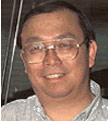Where are you from?I was born in Northern China but we moved when I was young, first to Taiwan and then to the Belgian Congo. I came to the United States for school and have been here ever since.
What did you study?
Chemical engineering, with an emphasis on polymer science. I received my BS from Berkeley and my PhD from Princeton.
Why chemical engineering?
Chemistry and engineering both came easy to me. Maybe it's a genetic predisposition: Both my father and daughter chose chemical engineering also. Luckily, I find chemical engineering fascinating. At Princeton, I spent a lot of time working on paint engineering problems.
How did you end up at GM?
I came to GM fresh out of school. But it was a package deal: They offered me a position in research and my wife one in marketing.
What project did you tackle first?
I was interested in recycling of polymers, primarily for environmental reasons and also for cost savings. My first project was to develop a fluidized bed reactor for incineration of paint sludge. That invention earned three U.S. patents.
What was next?
Once I helped solve the problem of what to do with the excess paint, the next step was to figure out how to have less excess paint to begin with. When you paint cars, some of the paint goes on the car and some goes down the drain. To cut the amount going down the drain, I worked on a paint application system called GM-ORACLE for GM Optimization of Robotic Painting for Lacquers and Enamels. I was the principal investigator for this one-coat paint technology, which achieved goals for environmental and coating quality, and saved GM considerable money in excess paint costs on every vehicle.
The technology has been implemented in all GM plants and was established as a GM Common Manufacturing Process Paint Standard. For my work, I received the Charles L. McCuen Award for a major research accomplishment and the Extraordinary Achievement Award, also called the Roger Smith Award after the former GM CEO. That award came with an added bonus: $10,000.
Have you worked in areas other than paint engineering?
Of course. For example, I helped develop the epoxy tooling known as STAMP or Superior Tooling and Molding Plastic. This epoxy is used for low-volume stamping dies. I worked on process optimization for the metallization of the tooling, which so far has been used to produce 84,000 parts. I received another patent for my work on the STAMP barrier coat and a GM Trade Secret Award for the STAMP Wax Adhesive for Metal Spray.
What has been your research focus lately?
I've been working on in-depth applications of robotics for painting. I knew little about robotics when I took on these projects, so I went back to school to learn. Our team began working on GM-RAPID (GM Robotic Application of Paintspray Intelligent Design), an industry-first paint optimization and simulation technology that uses vehicle CAD data to develop paint paths. The Detroit/Hamtramck Assembly Center has successfully implemented GM-RAPID in production on the 2000 LeSabre and 2000 DeVille.
In 1998, the Detroit/Hamtramck Assembly Center faced a dilemma when personnel realized that new robots coming online during GM's two-week July shutdown would not be able to use the old robots' paint paths. This meant that a plant engineer would have to reteach the paths, a time-consuming process that would have thrown off the production schedule.
In just a few months, our team from R&D and Detroit/Hamtramck successfully developed and implemented a technology known as GM-REACT (GM Robotic Engineering Application for Conversion and Transformation). GM-REACT allows a manufacturing engineer to convert and transform robotic paint paths quickly, while maintaining the original paint quality and almost eliminating manual teaching. Not only did the GM-RAPID team meet the production schedule, but we also won the 1998 People Make Quality Happen Team Award for these efforts.
Have all the projects you've worked on been successful?
Definitely not! I'm only talking about the successes today. Still, I've learned from all projects, whether successful or not. I think I'm starting on my 12th major project for GM now, which is a greater variety than most researchers pursue. I like new challenges, however.
Which of your accomplishments makes you most proud?
Any time the research work goes into the final product, as it has for GM-ORACLE, GM-RAPID, and GM-REACT. If we can develop a technology that production people think is better than what they are currently using, that says a lot about our research effort.
What do you do when you get to the office in the morning?
First I drink a cup of tea. Then I usually answer phone and e-mail messages, before I look at my list of Things to Do. Many mornings, I hold a meeting to plan the day's activities with my colleagues. From plant personnel, I've learned to keep these meetings as brief as possible and to focus on short-term accomplishments.
What do you do when you're not working?
I swim every day. Also, I love to play pool - I find it an intriguing mind game. And I watch a lot of TV, just like everyone else.




